How to make Manhattan-style Fermented Pickles with Garlic and Dill! An easy step-by-step guide to making the most flavorful, crunchy, tangy pickles full of healthy probiotics with only 20 minutes of hands-on time! The pickle brine is like a “tonic” -drink a shot daily to support a healthy gut! Video.
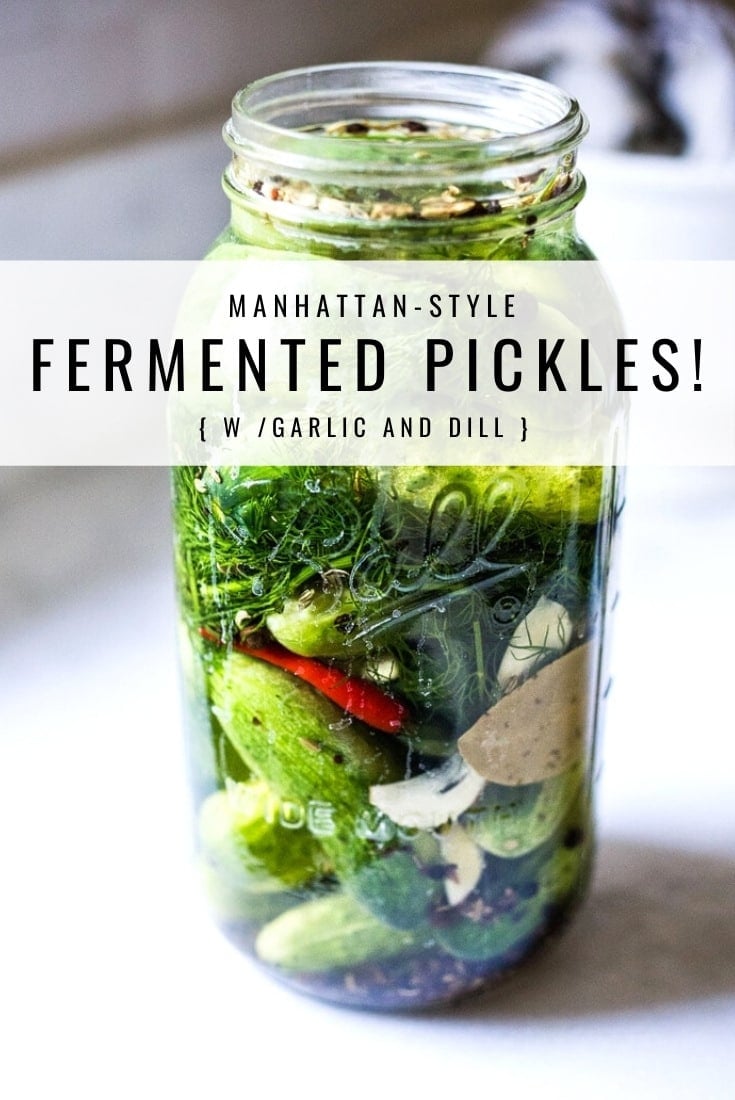
What happens when people open their hearts? They get better. ~Haruki Murakami
I’m excited to share this easy recipe for Fermented Pickles with you! If you are a crunchy pickle lover like me, you will be in heaven. Seriously, these are the best! These Manhattan-style “half-sour” fermented dill pickles are crispy, crunchy, flavorful, and oh-so alive!
Fermented in a salt brine, rather than vinegar, they get their delicious tanginess from light fermentation rather than vinegar.
Full of healthy, gut-healing, immunity-boosting probiotics these little guys are perfect as a low-calorie snack, or sliced and added to sandwiches or served as a tasty side.
Not only are they delicious and incredibly EASY to make, they are also incredibly good for us!
And as crazy as this may sound to some, the fizzy brine itself is like a healing tonic to me – I love to drink a shot of it- especially when I feel like my immunity needs a boost! So flavorful and totally energizing. Or try a Gin and Brine!
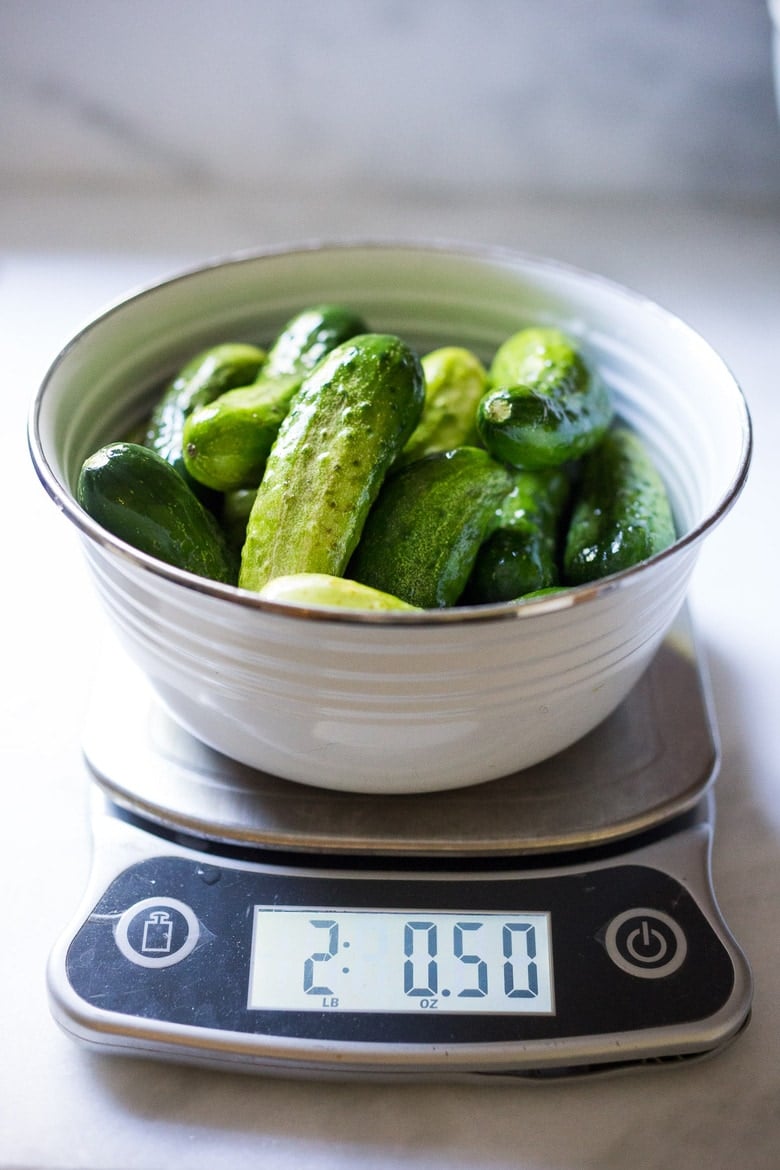
What you’ll need
- Pickling Cucumbers- Small and short (4 inches long) with thin bumpy skin, crisp texture, small seeds, a blocky shape and color gradient from light to dark. Varieties include Kirby, Calypso, Royal, Pickalot, National Picking, Adam Gherkin, Sassy, Eurika, Jackson, Boston Pickling, Northern Pickling… to name a few. You’ll need 2 lbs of “pickling cucumbers.” This recipe makes one large 1/2 gallon jar (or use two quart-sized jars) – a relatively small batch. Pickling cucumbers are most easily found at your local farmers’ market. Ask the farmers if they have “pickling cucumbers” they can help direct you to the right ones. Your pickles will only be as good as your cucumbers, so choose wisely! Make sure they are roughly the same size -about 4 inches long with 1 1/2-inch to 2-inch diameters – so they fit in the jar nicely and ferment at the same rate. I handpicked each one. They should be fresh and crisp with no soft spots.
- Salt-use fine sea salt, or fine Himalayan Pink salt
- Garlic and Onion – we load this up with 10-20 garlic cloves for the best flavor!
- Fresh Dill – use a big handful!
- Spices: Ground Turmeric ( adds fresh flavor) fennel seeds, mustard seeds, whole peppercorns, coriander seeds, whole allspice, dill seeds and celery seeds. Feel free to change or embellish! I added a couple of chilies for a little heat.
- Optional Tannic Acid: Bay leaves, grape leaves, oak leaves, or a couple of slices of fresh horseradish root. Cucumbers contain enzymes that soften them. To prevent this add a few bay leaves or a grape leaf to the jar.
- Two-Quart Mason Jar ( 8 cup mason jar)
- Fermentation weights
- Optional: Air lock, gasket, metal ring
How long does it take to ferment pickles?
These 3% Brined, half-sour crunchy pickles take 3-5 days of fermenting time.
The Brine: SALT TO WATER RATIO
- This recipe is a 3% salt water brine, which is considered “safe”. It equals 7 grams of salt per 1 cup of water. Or, 1 heaping teaspoon salt (1 1/4 teaspoon salt ) per 1 cup of water. This ratio allows one to drink the brine (like a shot) because it is not too salty and is designed for a shorter fermentation period ( 3-5 days). Crunchy, lightly fermented pickles!
- If you want a stronger brine for a longer ferment, feel free to go up to 4.5%. So for example, 3.5% Ratio= 9 grams of salt per 1 cup of water, 4.5% brine =10.8 grams of salt per 1 cup of water. For a 4.5% brine, half-sour pickles take 5-7 days, full sour pickles 14-21 days.
Fermented Pickles (step-by-step Instructions)
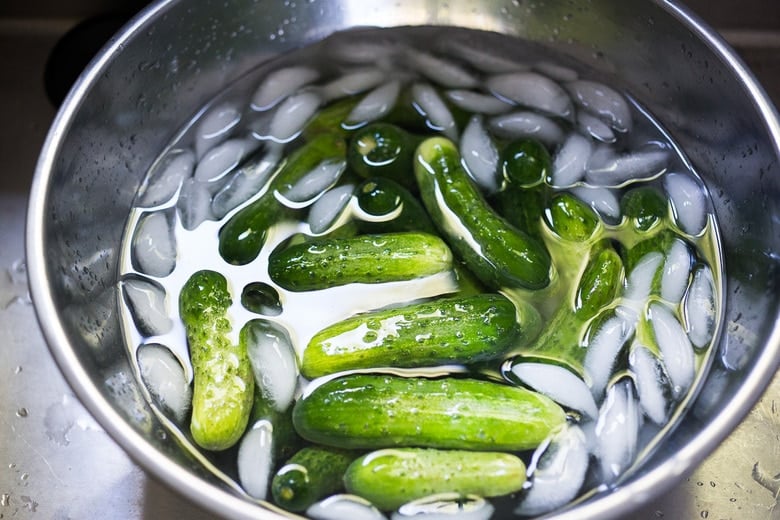
Step 1: Wash the cucumbers, slice off 1/16 inch of the blossom end, and soak them in an ice bath for 15-30 minutes to firm and crisp them up. There are enzymes in the blossom end that can make your pickles soft, so be sure to remove them.
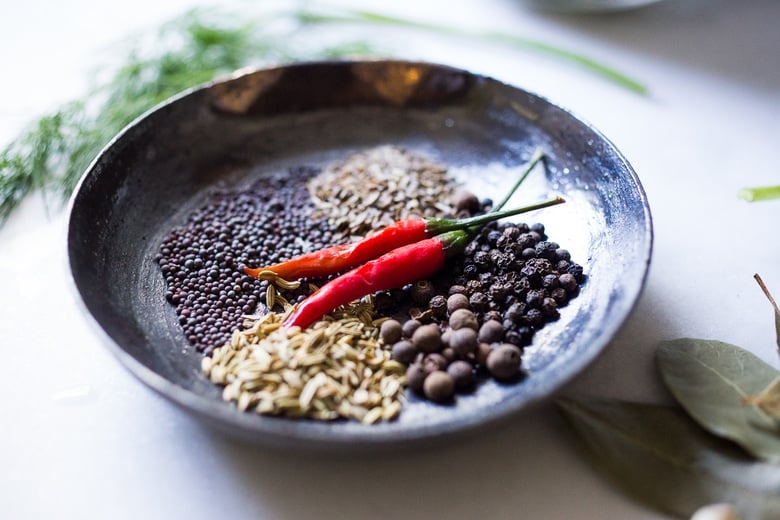
Step 2: Slice the garlic lengthwise and gather your spices.
Because these fermented pickles are left whole, you want the brine to be extra flavorful. I add a lot of garlic… 10-15 cloves, sometimes 20! Fermented Garlic is really good for the gut too!
Step 3: Place the spices on the bottom of the jar, then sliced garlic, fresh dill and bay leaves, and then add 2 layers of cucumbers, end on end, in a large two-quart jar (half-gallon). Press everything down.
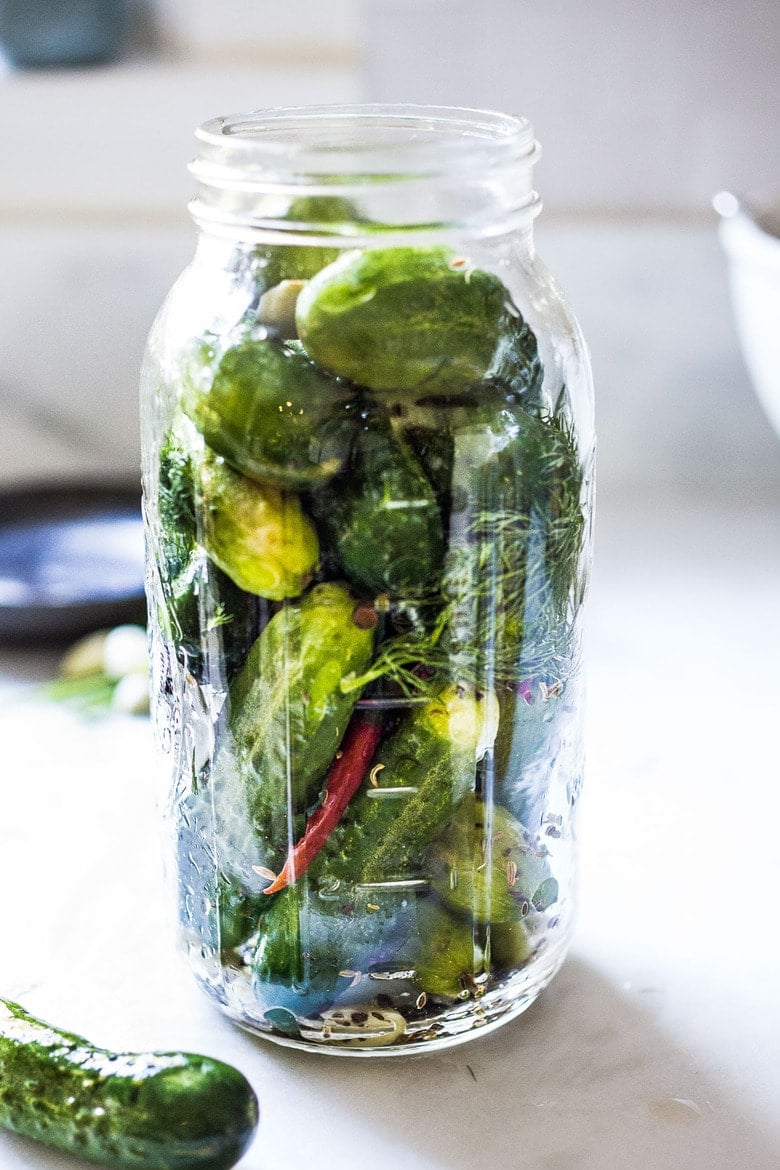
Step 4: Carefully measure and mix salt and water to create the 3% salt water brine- then pour this brine over the pickles leaving 1 1/2 inches of headroom.
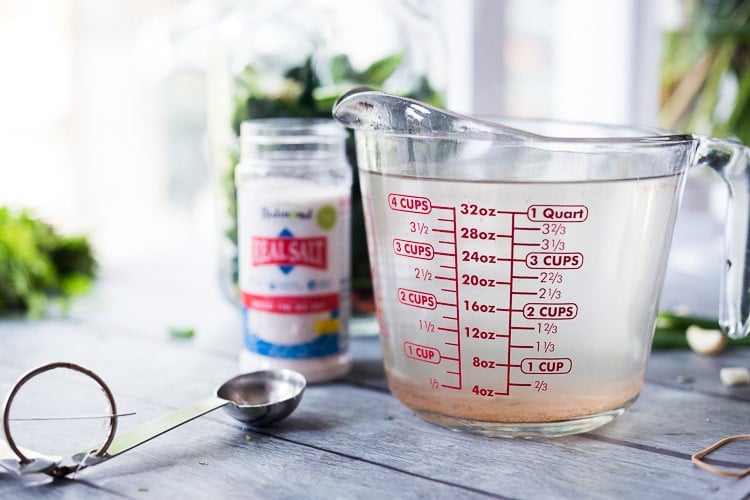
How salt works in fermentation:
- In a nutshell, using the right ratio of salt in fermentation encourages the growth of healthy bacteria while at the same time killing off bad bacteria. You want to be precise when measuring the salt and water in these kinds of recipes.
- Too much salt may kill off ALL of the bacteria -preventing fermentation.
- Too little salt will allow bad bacteria to keep on living. It is a fine balance. 😉
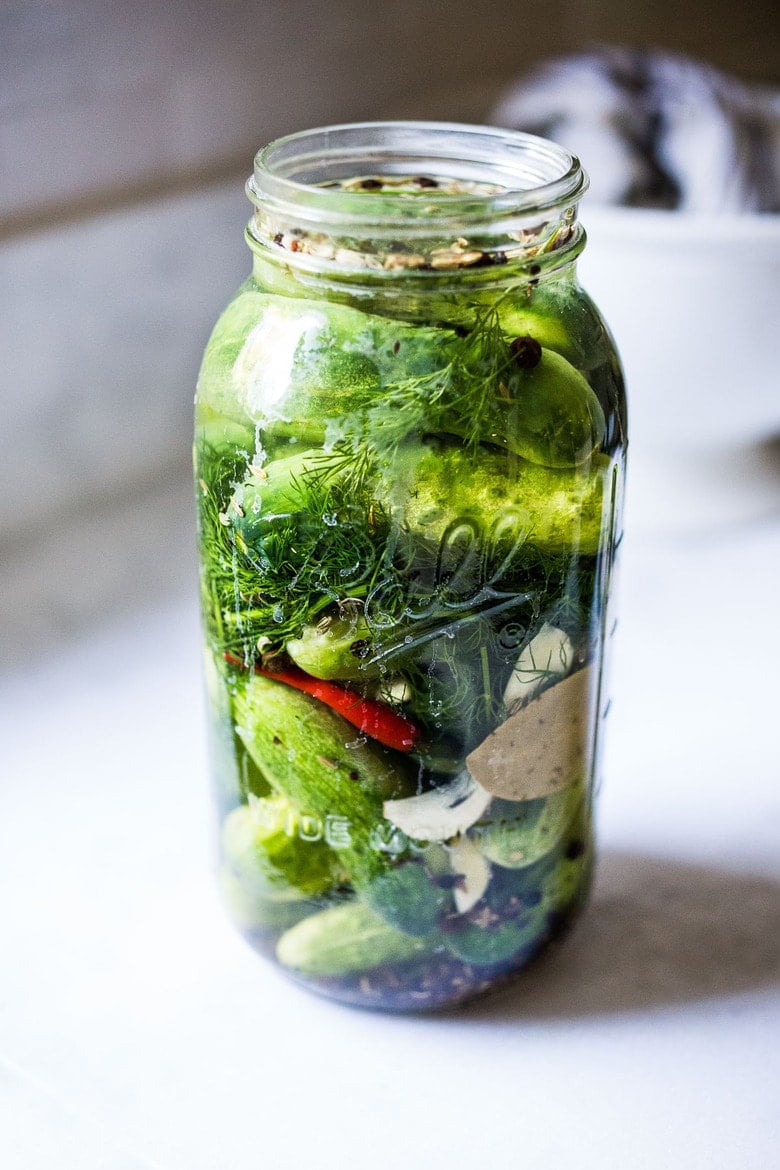
Step 5: Weigh down the cucumbers so they are completely submerged under the liquid, using a couple of fermentation weights, or a small zip lock bag filled with a little water (in a pinch).
MOLD: If the cucumbers or seeds are not submerged under the brine and become exposed to air- they can develop mold, so spoon any floaters out with a slotted spoon. Most seeds should stay submerged.
Step 6: Cover loosely with a lid or towel (to prevent bugs or flies from coming in, and to allow gases to escape) place in a bowl or pan to catch any overflow, and place in a cool dark place for 3-7 days, like the basement. You can also use and airlock lid- which allows air to escape, but nothing to fly in.
Step 7: Check after 2-3 days. Look for signs of life: bubbles/ or cloudy water. A cloudy brine is GOOD. Tap the jar and see if bubbles rise to the top. Check to see if any brine overflowed into the bowl ( both signs of life). This often takes about 3-5 days, I find 4 days is the “sweet spot”, depending on temperature. Cloudy brine is delicious and nutritious!
Step 8: Place the jar in the fridge to further slow the fermentation with a loose lid. They will continue to ferment very slowly and will keep indefinitely.
Expert Tips:
- Ferment at cooler temps (60-70F) to keep pickles crisp. If your home is hot, try placing in a cooler with ice. Take the temp of the brine.
- The longer you ferment them (unrefrigerated), the tangier they will get. But they will also get softer. I like them crisp, but you may want them tangier and softer. You can taste them at any point after you see bubbles.
- Smell: your ferment should smell tangy, garlic and fresh. If you notice anything foul or unpleasant, your ferment may have been contaminated: most commonly by dirty hands, dirty utensils, or a dirty jar.
- If you want to create a “fizzy” brine for drinking, tighten the lid, and burp daily if leaving out. You can tighten the lid in the fridge, but burp weekly. This will create a little pressure and give it some effervescence.
- Anything that touches air- may mold. Always fish out any floating spices with a slotted spoon to prevent this.
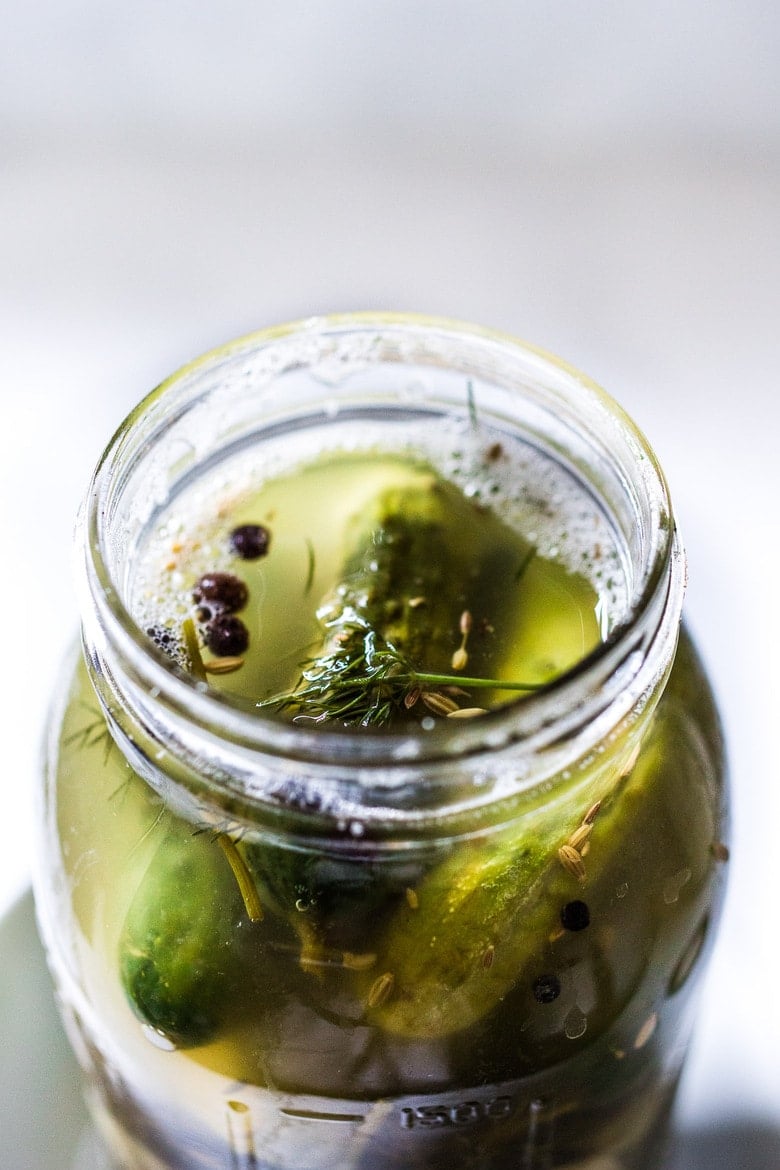
Once they are cold, give them a taste. They should be crunchy and flavorful! The brine is deliciously tangy, salty, and effervescent -so tasty and full of gut-supporting probiotics. The garlic is tasty too! Eat it!
I find myself often drinking shots of the brine! I also make this Gin & Brine Martini!
Let me know how you like this one in the comments below!
xoxoxo
More Favorite Ferments!
- Curtido & Cultured Salvadoran Slaw
- How to make Sauerkraut (Simple Cultured Cabbage)
- Beet and Cabbage Sauerkraut
- Cucumber Kimchi Pickles
- Turmeric Sauerkraut
More from Feasting at Home
How to make Fermented Pickles| 45-sec video
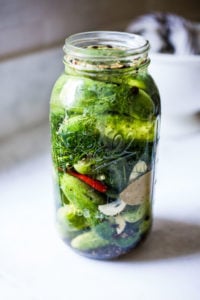
Homemade Pickles with Garlic and Dill
- Prep Time: 4 days
- Total Time: 4 days
- Yield: ½ gallon
- Category: fermented, preserved
- Method: fermented
- Cuisine: American
- Diet: Vegan
Description
How to make Manhattan-style, fermented Dill Pickles! A simple recipe for making the most flavorful, crunchy, tangy, garlic dill pickles with only 15 minutes of hands-on time. Full of healthy, gut-healing probiotics these little guys are perfect as a low-calorie snack, or sliced and added to sandwiches.
Ingredients
- 2– 2 1/2 lbs pickling cucumbers– all similar size ( 5 inches)
- 5 cups filtered water or tap water (that is not overly chlorinated)
- 2 tablespoons fine sea salt or Himalayan salt — or basically one heaping teaspoon fine sea salt (7 grams) per one cup of water, for a 3% brine (see notes)
- 1/4 teaspoon turmeric (optional, adds a “fresh” flavor)
- 1 teaspoon each: fennel seeds, coriander seeds, allspice, peppercorns, dill seeds, mustard seeds, celery seeds- and feel free to add more peppercorns!
- 10–20 garlic cloves, sliced (or double for extra garlicky)
- 1/2 onion, thinly sliced (optional)
- big handful of fresh dill
- 1–3 fresh red chilies – or dried arbol chilies, or add chili flakes (all optional)
- 3–4 bay leaves (or a grape leaf or oakleaf) – these are sources of tannic acid to help them stay crisp.
You’ll need a 1/2 gallon mason jar, crock, or 2 quart-sized jars- clean and sterile.
Instructions
- Prep Cucumbers: Rinse the cucumbers, remove 1/16-inch of the flower end of each cucumber (keeps them from getting soft) and place them in an ice-water bath, to crisp them up (15-30 minutes). Leave them whole.
- Make the brine: Mix salt (2 tablespoons) and 5 cups cold water until dissolved.
- Wash your hands, jar and any utensils. No need to sterilize, just clean!
- Assemble: In a large, clean two-quart mason jar, place all the whole spices into the bottom. Add the dill, garlic and onions or turmeric if using. With clean hands, pack one layer of cucumbers tightly, standing on end, then add the bay leaves, then add the second layer of cucumbers standing on end.
- Press everything down, leaving 1 ½ inches of headroom. Pour the salt water brine over the top and weigh down the cucumbers with fermentation weights so they are submerged under the brine. Remove any spices that may have floated to the surface (which can mold).
- Cover the jar loosely with a lid or with a cloth- basically, the pickles will bubble and you want air to be able to escape.
- Place the jar in a pan or bowl to collect any overflow and leave it in a cool dark place (60-70F) for 2 -3 days (a basement, or lower kitchen cupboard) and check for bubbles or overflow, indicating fermentation. Half sour pickles will take 3-5 days with crisp, white interiors. If is colder than 65F, it may take longer, if hotter, they will ferment faster. Full sour pickles will take 14-21 days (see notes for a stronger saltwater ratio).
- After 2 days, check for signs of life: bubbles, overflow, or clouding. Tap the jar, and see if tiny bubbles rise to the top. I usually ferment for 3-5 days. Longer ferments will yield tangier pickles but will get softer as they ferment, and lose their vibrant color. Up to you. You can taste them at any point after you see bubbles, and ferment longer if you like. The brine will get cloudy as it ferments- this is a good sign! Once you see active bubbles, you can at this point place the jar in the fridge, where it will continue to ferment, but much more slowly. Keep the pickles submerged.
- Once chilled, give them taste. They should be crispy and flavorful with a little tang. (At this point, if you want a tangier or softer pickle, you can absolutely pull them back out again and ferment for a few more days longer if you want.)
- If you like fizzy brine, tighten the lid, burping every week or so or try using an airlock. If you don’t want to think about it, give the lid one loose twist, so it’s on there, but gases can escape.
Notes
If you need more brine, make sure you use the same ratio- 1 heaping teaspoon sea salt per one cup of water.
If using a grape leaf, place it on the side of the jar, then layer the remaining ingredients.
If pickles turn out too soft- it may be due to too warm of temperature during fermentation, or the flower end wasn’t removed (the flower end of the cucumber has enzymes that can soften pickles).
Feel free to use 2, quart-size jars, dividing cucumbers, spices and brine between the jars.
BRINE: This recipe is a 3% salt water brine, which is considered “safe”. It equals 7 grams of salt per one cup of water. I’ve had really good luck with this ratio – and this ratio allows me to drink the brine (like a shot) this is really healthy – full of good gut-supporting bacteria!
If you want a stronger, saltier brine, feel free to go up to 4.5%. For a full sour pickle (14-21 days) use a 4.5% brine.
- 3% ratio = 7 grams salt per 1 cup of water. (1 1/4 teaspoon fine sea salt, per 1 cup water)
- 3.5% Ratio= 9 grams of salt per 1 cup of water. (1 1/2 teaspoon fine sea salt, per 1 cup water)
- 4.5% ratio 10.8 grams of salt per 1 cup of water. (2 teaspoons per cup of water)
Cutting the Cucumbers: I recommend leaving them whole. The texture is much better. After your first successful batch, feel free to experiment.
Nutrition
- Serving Size:
- Calories: 16
- Sugar: 1.3 g
- Sodium: 297.4 mg
- Fat: 0.2 g
- Saturated Fat: 0 g
- Carbohydrates: 3.7 g
- Fiber: 0.5 g
- Protein: 0.7 g
- Cholesterol: 0 mg
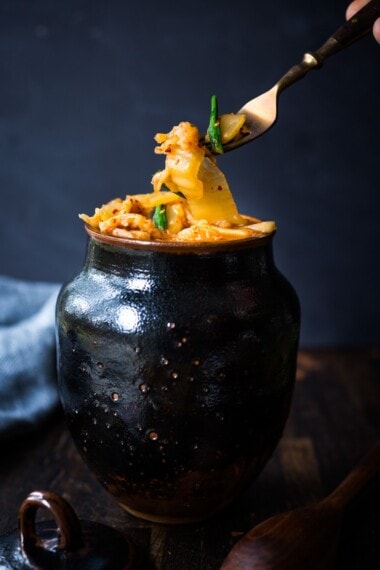
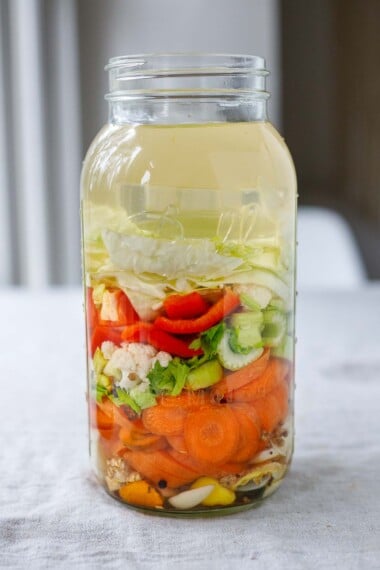
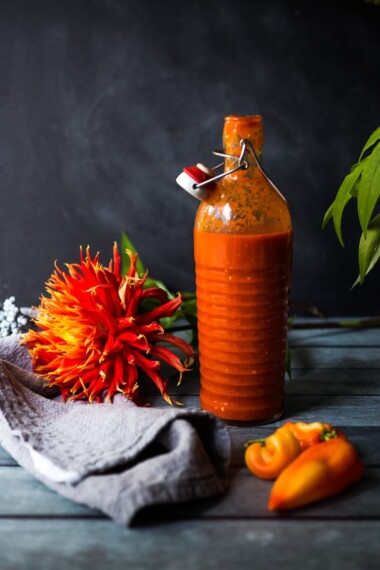



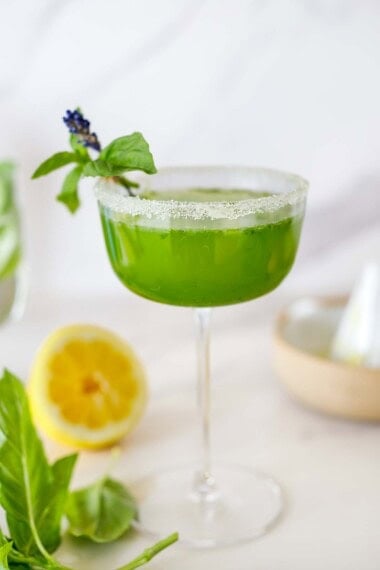
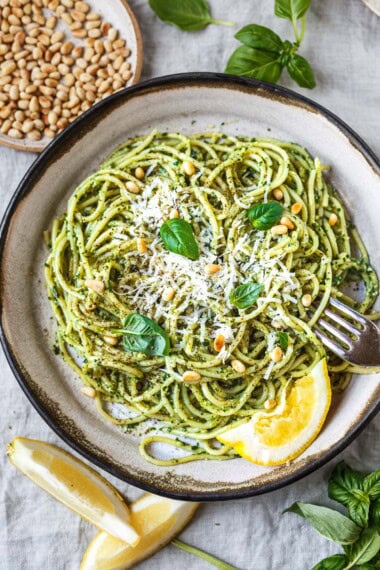

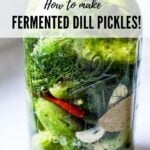
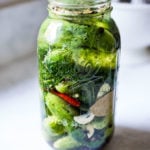
I let my pickles ferment for 4 days they’ve been in the refrigerator now for 2 weeks. I tried to pull them out and the insides just completely fall off of them they’re very mushy and very very tangy almost like hot peppers. Followed the recipe exactly. Can I get rid of some of the brine and just add water to slow the fermenting process further? They are uneatable now. Also, can I reuse the brine to make more or should I use fresh? I did slice the cukes into spears cause I could only get 2 whole cukes in the jars. I’ve since gotten half gallon jars so that is no longer a problem. They were very good till they turned to mush. Thank you.
Hi Barry, I’m so sorry to hear they fell apart. Shoot! Do you know the type of cucumber you used?
I can’t imagine why your pickles turned to mush, I’ve been corresponding with Sylvia for a couple of weeks, I have been trying a long ferment (5 weeks) I’ve had them on a shelf now for 2 weeks, everything seems to be fine, and I put loose lids on them last week and I give the jars a bit of a jiggle every day to release the gasses. I found a bit of mold today on a jar that did not have liquid over the pickles, took off the mold and everything looks good so far. (I did fill the jar with a bit more brine). as far as your mushy pickles go, for myself I would make a new brine and try again.. crappy when you lose your batch, so sorry
possibly cucs were not as fresh as they should have been?
you asked me for a link for the fermented pickles
here is is:
https://polishhousewife.com/ogorki-kiszone-polish-pickles/
Thanks Michael- I appreciate this. Feel free to try it- but take caution- I really think your jar would explode if tightened and left out of the fridge. I don’t see any reviews here so not sure if others tried this? If might be a fun experiment.
so I’ve got 6 quart jars sitting on my counter right now, with weights to keep the cukes and spices submerged, It might be a fun experiment or a very messy one 🙂 . I have many more cucumbers to harvest from my garden (as well as many other veggies) It’s been a bumper season for veggies for sure. I’ll let you know how everything turns out with the fermentation after 4 to 5 weeks.
Hi Michael, another thing I might do- and I think there is a note in the recipe card- but for longer ferments like this, increase the salt a little bit. ( you can just add to the jar if you didnt see this note). Also make sure to find a cool spot (that is under 70F). Your counter may be too warm? Try a lower cupboard or basement if possible.
thanks for the tip, not sure I can put them anywhere else, I live in a tiny home and cupboard space is at a premium for sur, bt I will try to find a cooler spot for them, I did up the salt just a bit for this little project. Thanks again
Perfect Michael- let me know how it goes! Curious. 😉
Hi Sylvia,
I BBQ’d some burgers this evening and tried out the pickles after about an 8 or 10 day ferment, turned out great!! Put on loose lids to keep the fermentation going on.
I believe I can tighten the lids after a couple more weeks.
recipe looks great, I’m going to try it today for one quart of these pickles, I have about 12 to 14 pounds of pickling cukes from my garden so far, and I’m going to can the rest (dill of course) I’m wondering if after 7 to 10 days of fermentation, I can just seal up the mason jar and let them sit without refrigeration?
Hi Michael- so they will continue to ferment, causing gases, which will make your jars explode if sealed. You don’t want that! 🙂 Refrigerating slows down the fermentation process.
okay thanks, I was thinking after about 5 weeks of fermentation they could be sealed and have a shelf life of about a year
Well you would have to stop the fermentation (hot water bath) which will kill all the healthy bacteria, so kind of pointless to ferment them if going this route. If wanting to can them, then don’t ferment.
I was reading another article that says after about 4 to 5 weeks the fermentation will be done and they can be sealed, no canning required, maybe you could check it out?
Can you send the link?
I’ve been wanting a recipe for a tangier, crunchier, “kosher” pickle and found this. Thank you. They sound delicious. I am curious if this would work for banana peppers.
I think it would- give it a try!
One of my jars is going great, the other got moldy. Can if be saved?!
Oh shoot. If the mold is just at the top and you can easily remove it, perhaps try that. Change the jar, and give it a day and smell for mold? 🙂
We tried fermenting a couple jars of cucumbers/pickles for the first time last year and ate them right up -Making double this year now. Question in regards to when you have them in the fridge and you and they are good and yummy … Can I take the weights out, remove burbee tops and put regular mason lids on? I got more cucumbers coming and I’ve run out of weights and burbee thingy’s.
Yes, absolutely once you refridgerate take the weights out, and use regular lids.
I did it! Taste great! I put them in frig today. 2 straight sided wide mouth canning jars and 2 regular shaped jars with regular size lids. 3 are hot spicy. All taste great.
NOW, I need to know: May I put a metal canning jar lid and ring on them, IF I burb them regularly? Or is metal a bad idea? 2 of them have a good fitting plastic lid that has a slot to slide open for drinking thru. I think that is good enough for those 2. The other 2 still have their original weighted little jars on top. They need lids.
The brine is not too salty for me to drink. I made two jar to your ratio and two to a bit more salt ratio. I used tons of fresh dill from my garden and younger horseradish leaves, fresh garlic, both dark and yellow mustard seeds, and red pepper flakes in 3 of them. Delicious! My first try at pickles and so glad I did these “healthy” probiotic ones you taught me about. Thank you! AND, please advise me on HOW to store in frig, meaning: what kind of lid / seal.
Hi Secilia! Either lid will work. You can use metal and not make it tight, just turn once.
Thank you. Your the greatest. Brine covering everything, is that still necessary with lids on and ferment in refrigerator? thank you!
I would. 🙂
Can you use this recipe for canning pickles?
No, Diana, this would not be the best recipe for canning.
Is the brine supposed to get cloudy? I’m on day 3 and see bubbles, but the brine is cloudy.
Yes, that is common and totally fine!
Which ingredient creates the carbon dioxide in the fermentation process?…
Does the skin on the cucumber contain yeast, (similar to grape skins)?
Yes Frank, the skin contains wild bacteria. That’s why I opt for farmers’ market, organic cucumbers.
Can spring water be used in the recipe? thanks.
Yes, that would work fine.
Do the pickles have to be refrigerated when finished? I’m assuming that they won’t have much of a shelf life like water bath canned pickles? Looks like a yummy recipe! Thanks for sharing!
Yes, they must be refrigerated!
How long do they keep after refrigeration?
Store them in the fridge, they keep indefinitely.
3% salt is not safe for cucumbers which are more prone to mold. 3.5%-5% is the proper formulation.
Thankfully your recipe is a quick ferment.
Hi Marie- I got the ratio from a retail Pickle Business that I had been purchasing from and haven’t had a problem with mold yet. If doing the quick 3-5 day ferment in cooler temps under 70F, this ratio actually works well. It is especially great if you want to drink the brine like I often do. I have made it many times! I have included other ratios in the post body itself and in the recipe notes that are higher and may be more appropriate for longer ferments.
Gonna try this… could you add lemon juice? Lemon peel? For a little more zing?
What if you add the peel, or juice after the first fermentation process, right before you refrigerate?
Can I use sliced Armenian cucumbers?
You could give it a try- they may not need as long to ferment- check after three days?
my cucumbers are long. can i cut them and use this same recipe?
I recommend using pickling cucumbers and leaving them whole- for your first batch. After that, feel free to experiment, but leave peels on. 🙂
I want to ferment dilly beans. Can I use this recipe or do you have one specifically for beans? Is the salt ratio different for different vegetables?
Hi Jeanine- I have not tried, but my guess is this would work great for dilly beans! Such a good idea. I think I might try it too! Thanks for the inspiration!
If I don’t have filtered water, could I use a bottle of sparkling water like San pelligrino? I’m afraid the chlorine from my tap could mess the the fermentation process
Hi Jessica, I’m not sure- I guess you could try it? Or leave out your tap water in a container overnight- some say chlorine will evaporate?
I made the pickles and they came out great! Thank you! How do I store them and stop the fermenting? Do I boil the liquid and add it back to the jar and keep in the fridge? Thanks!
Anthony
Hi Anthony, Why do you want to stop the fermenting? Placing it in the fridge as is- will greatly slow it down. Boiling will only kill all the lovely healthy bacteria you worked so hard to create. 😉
I am on day 4 of the fermenting process. I am curious how long the pickles way stay fresh in the fridge once they are ready.
Thank you for sharing the recipe!
I keep them in the fridge for months!
How long will these last in the fridge?
Indefinitely. 🙂
I started mine 2 days ago. I didn’t have any red chilies so I added a sliced Hungarian pepper to the jar. I will report back when done. A good idea for the weight is a half pint Ball mason jar as it will fit nicely inside any wide mouth canning jar. Also, I am trying air-locks instead of daily burping.
thanks Larry, let me now how it goes!
I got the sour I like at 9 days, and they are still firm. Now that they are in the fridge, do I still need to keep the pickles submerged in the brine with the weight?
Great to hear Larry! You can remove the weight.
These really turned out great! We usually buy Bubbies fermented pickles that are really good, but $10 a qt! We had some in the fridge, and did a comparison test. Hands down ours are better!!! Thanks for the recipe. This is our first ferment. Mine are not half sour, like yours, more like 3/4 sour (9 days) at 70-75F ferment temp, still super crisp, and not salty. Just perfect….BTW/ I did a 3% brine, and using the air locks and the tiny Ball jar as a weight, I didn’t get any mold. It seems there is a lot of opinions on the correct salt/water ratio. Again-thanks for the great recipe….
Appreciate this!
You don’t want a lid
Gregg wrote: “you don’t want a lid” What do you mean?
In case Gregg does not respond- you can ferment without a lid here, just make sure the fermentation weight sinks down far enough that a little layer of water is at the top of the jar and that no seeds, dill or cucumber are poking out (they will mold if they touch air). The lid is to keep any flies or bugs out.
Can these fermented pickles be canned or do they have to be kept in the refrigerator
They need to be kept in the fridge. Canning will mitigate all the health benefits.
I missed the weighing down step and my pickles developed a mold on top. Does that mean I need to toss them?
Oh Shoot Donna! I’m sorry. If the mold is actually on the cucumbers, I would toss. If the mold is only touching the whole spices and you can remove that portion easily, you may be able to salvage it? I guess it comes down to your comfort level.
Okay thanks. It was only on the dill on top but I’ll need to think about it. not worth getting sick.
Try removing the dill, put in a new clean jar, and sniff. If it smells like mold, toss?